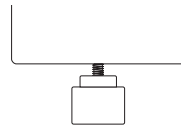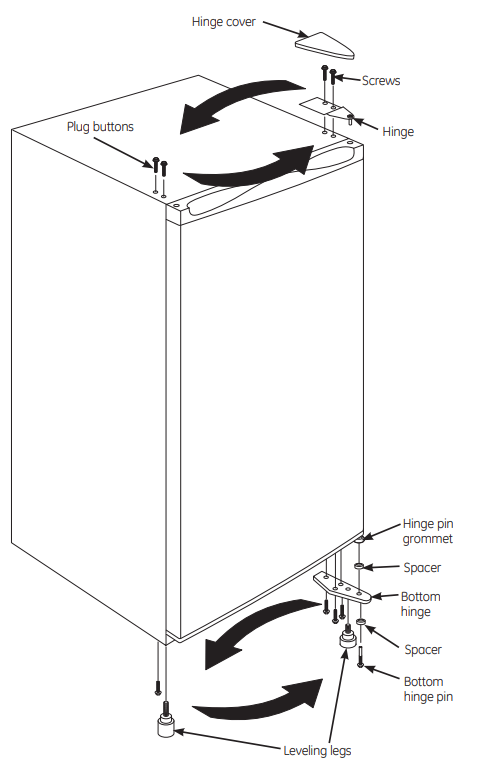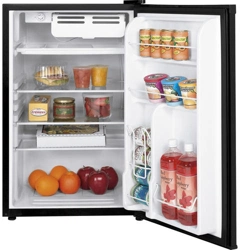Documents: Go to download!
User Manual
- User Manual - (English)
- Energy Guide - (English)
- About the control on the refrigerator.
- About the refrigerator features.
- Care and Cleaning
- Preparing to install the refrigerator.
- Troubleshooting Tips
- SAFETY PRECAUTIONS
Table of contents
User Manual Refrigeration
About the control on the refrigerator.

The control will look like the one above. The arrow indicates the setting selected.
Control Settings
The temperature control maintains the temperature in the refrigerator. 1 is the warmest setting; higher numbers are colder settings with 7 being the coldest setting. The typical setting is 3.
Allow 24 hours for the refrigerator to reach the desired temperature.
If you want a colder or warmer temperature, move the dial one setting at a time. Moving the control to 0 stops cooling but does not turn off the power to the refrigerator. Setting the control too high may cause freezing in the refrigerator depending on the room temperature.
How To Test Temperatures
Use the milk test. Place a container of milk on a shelf and check it a day later. If the milk is too warm or too cold, adjust the temperature control.
After changing the control, allow 24 hours for the refrigerator to reach the temperature you have set.
About the refrigerator features.
Shelves
To remove a shelf, lift up the back slightly and pull forward. Some models have multi-position shelves that can be moved to different levels.
Ice Tray Compartment
This compartment is designed for production of ice cubes and shortterm storage (a few days at most) of some commercially-frozen foods when in contact with the evaporator (cold surface in compartment.)
Door Shelves
Shelves on the door provide convenient storage for frequently used items. Some models have doors that are deep enough to store large bottles.
Care and Cleaning
Cleaning the Outside
Keep the outside clean. Wipe with a clean cloth lightly dampened with kitchen appliance wax or mild liquid dish detergent. Dry and polish with a clean, soft cloth.
Do not wipe the refrigerator with a soiled dish cloth or wet towel. These may leave a residue that can erode the paint. Do not use scouring pads, powdered cleaners, bleach or cleaners containing bleach because these products can scratch and weaken the paint finish.
Protect the paint finish. The finish on the outside of the refrigerator is a high quality, baked−on paint finish. With proper care, it will stay new−looking and rust−free for years. Apply a coat of kitchen/appliance wax when the refrigerator is new, and then at least twice a year.
Cleaning the Inside
To help prevent odors, leave an open box of baking soda in the refrigerator.
Unplug the refrigerator before cleaning. If this is not practical, wring excess moisture out of sponge or cloth when cleaning around the control.
Use warm water and baking soda solution−about a tablespoon (1E ml) of baking soda to a quart (1 liter) of water. This both cleans and neutralizes odors. Rinse and wipe dry.
Other parts of the refrigerator−including door gaskets, fruit and vegetable drawers, and all plastic parts−can be cleaned the same way.
Do not wash any plastic refrigerator parts in the dishwasher.
Defrosting (on manual defrost models with freezer area)
Defrost whenever frost on the wall of the ice tray compartment becomes 1/4" thick. Never use a sharp or metallic instrument to remove frost as it may damage the cooling coils. (A punctured cooling coil will cause serious problems and void the warranty.) We recommend using a plastic scraper. Do not use any electrical device in defrosting your refrigerator.
To defrost:
- Remove foods and ice trays from the ice tray compartment.
- Set the temperature control dial at O (off) position.
- On models without a drip tray, place a pan beneath the ice tray compartment to collect water.
Defrosting usually takes a few hours. To defrost faster, keep the door open. Also, pouring warm (not hot) water on the frosted part may speed defrosting. Do not use boiling water—it may damage plastic parts.
After defrosting:
- Empty water from the drip tray or from the pan placed beneath the ice tray compartment. Wash the tray or pan with warm water.
- Wipe the ice tray compartment with a damp cloth.
- Turn the temperature control to the desired setting and return food and ice trays to the refrigerator.
NOTE: If ice buildup is very thick, it may keep the ice tray compartment door from opening or closing completely. Don't try to force it open; after defrosting, the door will open and close easily.
Preparing for Vacation
For long vacations or absences, remove food and unplug the refrigerator. Move the control to the O (off) position, and clean the interior with a baking soda solution of one tablespoon (15 ml) of baking soda to one quart (1 liter) of water. Leave the door open.
Preparing to Move
Secure all loose items such as shelves and ice trays by taping them securely in place to prevent damage.
Be sure the refrigerator stays in an upright position during moving.
Preparing to install the refrigerator.
Read these instructions completely and carefully.
Refrigerator Location
- Do not install the refrigerator where the temperature will go below 50°F (10°C) because it will not run often enough to maintain proper temperatures.
- Install it on a floor strong enough to support it fully loaded.
- Do not install it closer than 5” (13 cm) next to a range.
- Do not install it in a recessed area.
- Do not build in the refrigerator.
Clearances
Allow the following clearances for ease of installation and proper air circulation.
Sides 1/2” (13 mm)
Top 2" (51 mm)
Back 2" (51 mm)*
*From the rear cabinet surface to the wall
Leveling Legs

Turn counterclockwise to raise, clockwise to lower.
Adjustable legs at the front corners of the refrigerator should be set so the refrigerator is firmly positioned on the floor and the front is raisedjust enough that the door closes easily when opened about halfway.
To adjust the leveling legs, turn the legs counterclockwise to raise the refrigerator, clockwise to lower it.
Door Reversal
- Remove the two plug buttons on the top left of the cabinet.
- Remove the plastic hinge cover by gently pressing forward and lifting by the back edge.
- Remove the two screws from the top hinge.
- Lift the top hinge up and off of the refrigerator.
- Lift the door up and off of the bottom hinge.
- Remove the hinge pin grommet from the bottom of the door on the right side and insert into the left side.
- Tilt the refrigerator cabinet backward.
- Remove the hinge pin. Keep the two spacers for reinstallation.
- Remove the hinge leveling leg and the three screws to remove the bottom hinge on the right side.
- Remove the case leveling leg and the case screw from the left side. Notice that the case leveling leg is different from the hinge leveling leg.
- Flip the bottom hinge plate to install on the left side of the refrigerator.
- Screw the three bottom hinge screws into place.
- Put a spacer between the hinge pin and the bottom hinge and screw the hinge pin into place.
- Place the second spacer between the hinge pin and the door. Position the door on the bottom hinge.
- While the magnetic gasket holds the door in place, secure the top hinge with two screws.
- Replace the hinge cover on the top hinge.
- Place the two plug buttons in the holes on the right side of the refrigerator cabinet.

Troubleshooting Tips
Problem | Possible Causes | What To Do |
Refrigerator does not operate | Control in 0 (off) position. | Move the control to a temperature setting. |
| Refrigerator is unplugged. | Push the plug completely into the outlet. |
| The fuse is blown/circuit breaker is tripped. | Replace fuse or reset the breaker. |
Vibration or rattling (slight vibration is normal) | Front leveling legs need adjusting. | See Leveling Legs. |
Refrigerator is on an uneven surface. | Use shims to level the refrigerator. | |
Motor operates for long periods or cycles | Normal when refrigerator is first plugged in. | • Wait 24 hours for the refrigerator to completely cool down. |
| Often occurs when large amounts of food are placed in refrigerator. | This is normal. |
| Door left open. | Check to see if package is holding door open. |
| Hot weather or frequent door openings. | This is normal. |
| Temperature control set at the coldest setting. | See About the control. |
| Not enough clearance from the wall. | See Clearances in Preparing to install the refrigerator. | |
Refrigerator too warm | Temperature control not set cold enough. | See About the control. |
| Warm weather or frequent door openings. | Set the temperature control one step colder. See About the control. |
| Door left open. | Check to see if package is holding door open. |
| Cabinet sides are warm | This is normal for a hot wall type condenser. |
Refrigerator has odor | Foods transmitting odor to refrigerator. | Foods with strong odors should be tightly wrapped. Keep an open box of baking soda in the refrigerator; replace every three months. |
| Interior needs cleaning. | See Care and cleaning. |
| Defrost water pan needs cleaning. | See Care and cleaning. |
Moisture forms on outside of refrigerator | Not unusual during periods of high humidity. | • Wipe surface dry. |
Moisture collects inside (in humid weather, air carries moisture into refrigerator when door is opened) | Too frequent or too long door openings. | |
Refrigerator too cold | Temperature control set too cold. | See About the control. |
SAFETY PRECAUTIONS
When using electrical appliances, basic safety precautions should be followed, including the following:
- This refrigerator must be properly installed and located in accordance with the Installation Instructions before it is used.
- Do not allow children to climb, stand or hang on the shelves in the refrigerator. They could damage the refrigerator and seriously injure themselves.
- Do not store or use gasoline or other flammable vapors and liquids in the vicinity of this or any other appliance.
- Keep fingers out of the "pinch point" areas; clearances between the doors and cabinet are necessarily small. Be careful closing doors when childrenare in the area.
- Unplug the refrigerator before cleaning and making repairs.
- GE does not support any servicing of the refrigerator.
- Turning the temperature control dial to the 0 (off) position stops cooling but does not shut off power to the refrigerator.
A DANGER! RISK OF CHILD ENTRAPMENT PROPER DISPOSAL OF THE REFRIGERATOR
Child entrapment and suffocation are not problems of the past. Junked or abandoned refrigerators are still dangerous... even if they will sit for "just a few days." If you are getting rid of your old refrigerator, please follow the instructions below to help prevent accidents.
Before You Throw Away Your Old Refrigerator or Freezer:
- Take off the doors.
- Leave the shelves in place so that children may not easily climb inside.
Refrigerants
All refrigeration products contain refrigerants, which under federal law must be removed prior to product disposal. If you are getting rid of an old refrigeration product, check with the company handling the disposal about what to do.
USE OF EXTENSION CORDS
Because of potential safety hazards under certain conditions, we strongly recommend against the use of an extension cord.
However, if you must use an extension cord, it is absolutely necessary that it be a UL-listed, 3-wire grounding type appliance extension cord having a grounding type plug and outlet and that the electrical rating of the cord be 15 amperes (minimum) and 120 volts.
HOW TO CONNECT ELECTRICITY
Do not, under any circumstances, cut or remove the third (ground) prong from the power cord. For personal safety, this appliance must be properly grounded.
The power cord of this appliance is equipped with a 3-prong (grounding) plug which mates with a standard 3-prong (grounding) wall outlet to minimize the possibility of electric shock hazard from this appliance.
Have the wall outlet and circuit checked by a qualified electrician to make sure the outlet is properly grounded.
If you have only a standard 2-prong wall outlet, it is your personal responsibility and obligation to have it replaced with a properly grounded 3-prong wall outlet.
The refrigerator should always be plugged into its own individual electrical outlet which has a voltage rating that matches the rating plate.
This provides the best performance and also prevents overloading house wiring circuits which could cause a fire hazard from overheated wires.
Never unplug your refrigerator by pulling on the power cord. Always grip plug firmly and pull straight out from the outlet.
Repair or replace immediately all power cords that have become frayed or otherwise damaged. Do not use a cord that shows cracks or abrasion damage along its length or at either end.
When moving the refrigerator away from the wall, be careful not to roll over or damage the power cord.
See other models: GSH25ISXNSS AJES10DCCM2 PGP943DET2BB JGBP26AEA1AA JGBP28SEM7SS
